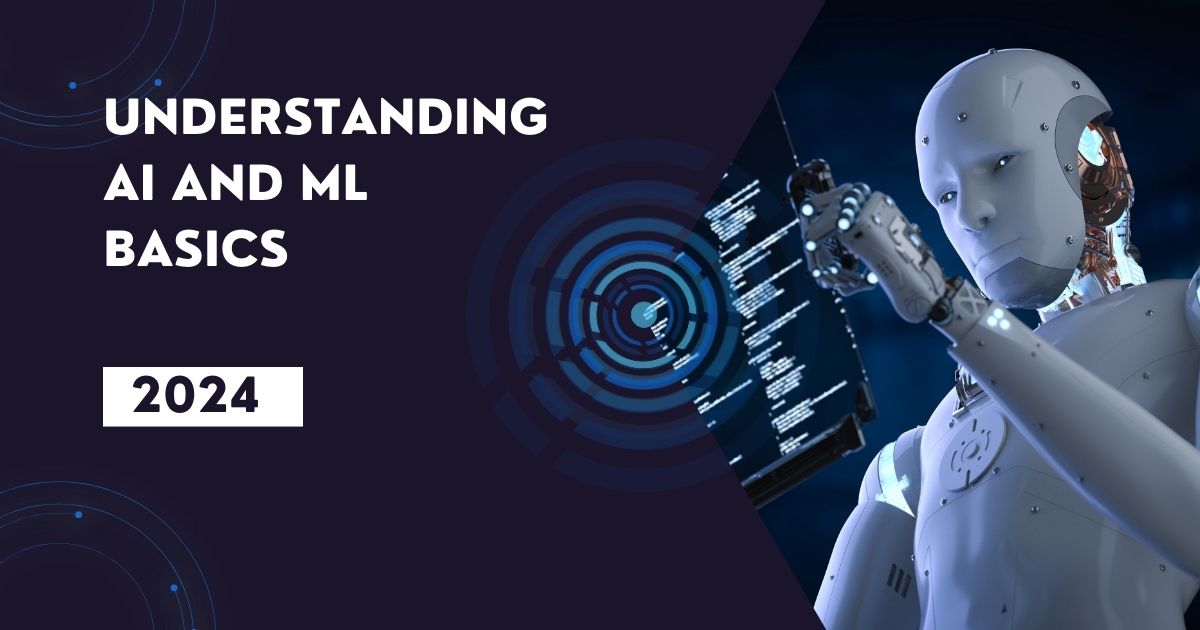Understanding the Basics of Artificial Intelligence and Machine Learning

Artificial Intelligence (AI) and Machine Learning (ML) have rapidly evolved into integral parts of our digital ecosystem. From virtual assistants like Siri and Alexa to more complex applications like predictive analytics in finance and healthcare, AI and ML are revolutionizing how industries operate and make decisions.
This blog will explore the foundational concepts of AI and ML, providing a clear understanding of how these technologies work and offering code snippets to demonstrate their practical applications. This article will guide you through:
- What is Artificial Intelligence?
- The Difference Between AI, Machine Learning, and Deep Learning
- Key Algorithms in Machine Learning
- Practical Examples of AI and ML
- Code Snippets for Getting Started with AI/ML
By the end of this guide, you'll have a strong grasp of how AI and ML work and how to begin implementing these technologies in your projects.
What is Artificial Intelligence?
Artificial Intelligence (AI) refers to the simulation of human intelligence in machines that are programmed to think, learn, and problem-solve like humans. The goal of AI is to create systems capable of performing tasks that would typically require human intelligence, such as visual perception, speech recognition, decision-making, and language translation.
AI can be classified into two categories:
Narrow AI (Weak AI): Systems designed to perform a specific task, such as facial recognition, without possessing general intelligence. Example: A self-driving car.General AI (Strong AI): Hypothetical systems that possess the capability of understanding, learning, and performing tasks just like a human being.
The Difference Between AI, Machine Learning, and Deep Learning
Before diving into Machine Learning, it’s important to distinguish between AI, Machine Learning (ML), and Deep Learning (DL):
Artificial Intelligence (AI): The broad field that aims to simulate human intelligence in machines.Machine Learning (ML): A subset of AI that enables machines to learn from data and improve their performance over time without explicit programming.Deep Learning (DL): A specialized subset of ML that uses neural networks with multiple layers (hence “deep”) to analyze large datasets.
Here’s a visual breakdown to help conceptualize the relationship between these terms:
While AI is the overall concept of machines performing tasks in a smart way, ML focuses on data-driven learning, and DL dives into neural networks to build complex, powerful models.
Key Concepts in Machine Learning
Machine Learning allows systems to learn from data rather than following a fixed set of rules. To understand ML, let’s break it down into some basic terms:
-
Supervised Learning: In this type of learning, the model is trained on labeled data, meaning the algorithm knows the correct answer for each input. This helps the algorithm learn from the data and make predictions on unseen data. Common algorithms include Linear Regression and Decision Trees. -
Unsupervised Learning: Here, the model is provided with data that lacks labeled responses. The algorithm tries to find hidden patterns and structures in the data. A well-known example is clustering with algorithms like K-means. -
Reinforcement Learning: This type of learning involves teaching an agent how to act in a specific environment by rewarding it for correct decisions and penalizing it for wrong decisions. The agent learns over time to optimize its behavior.
Algorithms in Machine Learning
Now, let's explore some of the most commonly used Machine Learning algorithms. Each has its own strengths and is suited for different tasks:
1. Linear Regression
Linear regression is a fundamental algorithm used for predicting a continuous output variable based on one or more input features.
Code Snippet: Linear Regression in Pythonfrom sklearn.linear_model import LinearRegression
import numpy as np
# Sample data (input features and target variable)
X = np.array([[1], [2], [3], [4], [5]])
y = np.array([5, 7, 9, 11, 13])
# Initialize and fit the Linear Regression model
model = LinearRegression()
model.fit(X, y)
# Predicting for a new data point
prediction = model.predict(np.array([[6]]))
print(f"Prediction for input 6: {prediction}")
2. Logistic Regression
Logistic regression is commonly used for binary classification tasks, such as determining whether an email is spam or not.
Code Snippet: Logistic Regression in Pythonfrom sklearn.linear_model import LogisticRegression
# Sample data (input features and target variable)
X = [[0.5], [1.5], [2.5], [3.5], [4.5]]
y = [0, 0, 1, 1, 1]
# Initialize and fit the Logistic Regression model
model = LogisticRegression()
model.fit(X, y)
# Predicting for a new data point
prediction = model.predict([[2]])
print(f"Prediction for input 2: {prediction}")
3. Decision Trees
Decision trees are a popular method used for both classification and regression tasks. They model decisions and their possible consequences as a tree-like structure.
Code Snippet: Decision Trees in Pythonfrom sklearn.tree import DecisionTreeClassifier
# Sample data (input features and target variable)
X = [[0, 0], [1, 1]]
y = [0, 1]
# Initialize and fit the Decision Tree model
model = DecisionTreeClassifier()
model.fit(X, y)
# Predicting for a new data point
prediction = model.predict([[0, 1]])
print(f"Prediction for input [0, 1]: {prediction}")
Practical Examples of AI and ML
Let’s explore some real-world applications of AI and ML:
1. Recommendation Systems
Many companies, including Netflix and Amazon, use AI-powered recommendation systems to suggest content or products to users based on their previous interactions.
How it works: By analyzing user preferences and behaviors, ML algorithms can predict what products or content a user is likely to enjoy next.
2. Natural Language Processing (NLP)
NLP is the AI subfield concerned with interactions between computers and human language. Applications of NLP include chatbots, machine translation, and sentiment analysis.
Code Snippet: Sentiment Analysis Using NLPfrom textblob import TextBlob
# Sample text
text = "I love this new phone, it's fantastic!"
# Perform sentiment analysis
blob = TextBlob(text)
sentiment = blob.sentiment
print(f"Sentiment: {sentiment}")
3. Image Recognition
Image recognition is another powerful AI application used in areas like medical diagnostics, autonomous vehicles, and security systems.
How it works: Deep learning models, particularly Convolutional Neural Networks (CNNs), are trained on labeled images to recognize patterns and classify objects.
Code Snippet: Simple Image Recognition Using Kerasfrom tensorflow.keras.models import Sequential
from tensorflow.keras.layers import Dense, Conv2D, Flatten
# Initialize the CNN model
model = Sequential()
# Add layers (input layer, convolutional layers, and output layer)
model.add(Conv2D(64, kernel_size=3, activation='relu', input_shape=(28, 28, 1)))
model.add(Flatten())
model.add(Dense(10, activation='softmax'))
# Compile the model
model.compile(optimizer='adam', loss='categorical_crossentropy', metrics=['accuracy'])
# Summary of the model
model.summary()
Getting Started with Machine Learning: Step-by-Step Guide
1. Data Collection
The first step in any ML project is gathering data. This data could come from sensors, databases, logs, or even public datasets available online. The quality and quantity of data play a significant role in how well your ML model performs.
2. Data Preprocessing
Before feeding the data into the model, it’s essential to clean and preprocess it. This involves handling missing values, scaling features, and encoding categorical variables. Libraries like pandas and scikit-learn are invaluable here.
import pandas as pd
from sklearn.preprocessing import StandardScaler
# Load sample data
data = {'Height': [5.1, 5.5, 6.0, 5.8], 'Weight': [130, 150, 180, 160]}
df = pd.DataFrame(data)
# Standardizing the data
scaler = StandardScaler()
scaled_data = scaler.fit_transform(df)
print(f"Scaled Data:\n {scaled_data}")
3. Model Selection
Next, choose the right algorithm based on the task (regression, classification, etc.). Tools like scikit-learn offer a variety of algorithms to test and experiment with.
4. Model Training
This is where the real learning happens. The model is trained using the available data by adjusting weights and minimizing errors (loss function). This is usually done in batches over multiple iterations called epochs.
5. Model Evaluation
After training, the model’s performance is evaluated using unseen data (test set). Evaluation metrics like accuracy, precision, and recall help determine how well the model generalizes to new data.
6. Deployment
Once a satisfactory model is built, it can be deployed in a production environment to make real-time predictions.
Future of AI and Machine Learning
The future of machine learning (ML) is poised for transformative growth, expanding its role across industries with unprecedented speed and efficiency. With advancements in computational power, access to vast amounts of data, and innovations in algorithms, ML is becoming more capable of solving complex real-world problems. From healthcare and finance to transportation and entertainment, industries will increasingly rely on ML for predictive analytics, personalized experiences, and autonomous decision-making. The integration of machine learning with other technologies like edge computing, blockchain, and the Internet of Things (IoT) will further enhance its impact, enabling smarter, real-time solutions in dynamic environments.
Another key trend shaping the future of machine learning is the rise of ethical AI. As ML models are deployed at scale, issues such as bias, fairness, transparency, and accountability are becoming increasingly important. Companies and researchers are focusing on developing responsible AI frameworks that mitigate bias and ensure equitable outcomes across diverse populations. Moreover, interpretability and explainability will play critical roles in fostering trust in AI systems, especially in sectors like healthcare and legal. This ethical shift will be accompanied by stricter regulations and governance, ensuring that machine learning applications align with societal values and legal standards.
Conclusion
Artificial Intelligence and Machine Learning are transforming industries by automating tasks, providing insights, and enabling smarter decision-making. From linear regression to deep neural networks, understanding the foundational concepts of these technologies is key to building intelligent systems.
